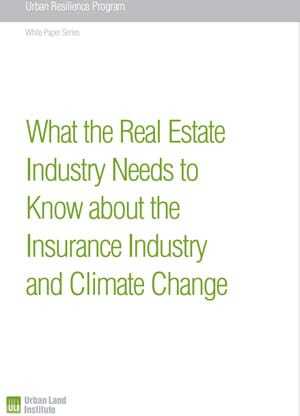A new white paper by the Urban Land Institute (ULI) finds that while the insurance industry is a leader in developing risk standards for natural disasters, the real estate sector and governments also must play an active role in climate change adaptation. Titled What the Real Estate Industry Needs to Know about the Insurance Industry and Climate Change, the report draws on data and analysis provided by Lloyd’s of London to conclude that accurately priced insurance alone cannot mitigate the impacts of climate change on the built environment. The report instead advocates that continued investment into resilience infrastructure and reforms in current development practices are also necessary.
According to the report, the increasing frequency of extreme weather brought on by climate change adversely affects real estate values and increases the probability of property damage occurring in urban areas. In the last ten years alone, direct losses in real estate and infrastructure as a result of natural disasters has tripled, reaching $150 billion per year. The paper highlights the steps the insurance industry has taken to adopt risk standards for climate change across the industry, from catastrophe models and scenario analysis to insurance products that incentivize risk-reducing building practices.
However, the report maintains that the insurance industry’s efforts alone are not enough to confront the extensive property damage wrought by climate change. The insurance industry does take considerable steps to encourage risk reduction and advocate for better climate policies, such as offering incentives to reward practices that aim to reduce the risks of natural disasters and creating national and international advocacy organizations to address climate change issues. However, governments and the real estate industry have the final say in development practices, infrastructure investments, building standards, and site selection. Because of this, the paper concludes that a successful approach to climate change adaptation in the built environment would involve collaborative efforts from the insurance industry, government, and the real estate industry.
“It remains a concerning issue that much of the world’s most expensive and desirable real estate is built in locations that are vulnerable to the effects of climate change,” comments Patrick L. Phillips, global chief executive of the Urban Land Institute. “We are hoping that our new white paper will lead to a broader debate on the issue of insuring and reinsuring real estate at risk of damage from extreme weather events.”
The white paper includes case studies of flood insurance in four countries: Canada, Germany, the United States, and the United Kingdom. Comparisons between these countries reveal the different approach each one takes to insuring against natural hazards. According to the report, major differences include whether the cost of repair and recovery is paid by the government or by the private insurance industry, what is considered insurable, how risk is communicated, how reinsurance is purchased, and market penetration. The paper makes the following key observations in these areas.
Payment
Payment responsibility for flooding damage varies across the four countries. In Canada, where flooding is considered uninsurable, the national and provincial governments bear the costs of flood recovery. In the United States, the federal government is responsible for selling the vast majority of flood insurance policies through the National Flood Insurance Program (NFIP); while in Germany, both the private insurance industry and the national government help with flood recovery. In the United Kingdom, private insurers pay for flooding damage. Negotiations are underway to set up Flood Re, a nonprofit flood reinsurance fund owned and run by the U.K. insurance industry, which will aim to cover damages on high-risk policies.
The paper concludes that the governments of the United States, Canada, and Germany can expect to take substantial budget hits from flooding disaster recovery, while ongoing negotiations make the situation in the U.K. less clear.
Insurability
All overland flooding is considered uninsurable in Canada, and certain types of flooding (storm surge and flooding in certain high-risk areas) is uninsurable in Germany. For the time being, the United States and the United Kingdom both have safeguards in place to prevent many kinds of property from becoming uninsurable. However, the paper points out that these safeguards come at the price of higher premiums and public demands for subsidies through premium caps or exemptions.
Communicating Risk
In Germany, the United States, and the United Kingdom, flood risk is communicated through a combination of flood-hazard mapping and insurance prices. Private insurers take the lead on risk mapping in Germany; while the national government is responsible for doing so in the United States and the U.K. Since Canada does not offer flood insurance, it is solely up to land use experts to communicate flood risk to property investors. The report also notes that inadequate flood mapping in Canada remains an obstacle to introducing flood insurance.
Reinsurance
The U.S. government does not require the NFIP to buy reinsurance; instead, claims exceeding reserves are borrowed from the U.S. Treasury. In Germany and—at least currently—in the U.K., the private insurance industry buys reinsurance on the international market. However, the paper points out that the U.K. may soon shift to the Flood Re program for reinsurance.
Market Penetration
In response to low market penetration of natural hazard insurance in Germany, the German government has made several attempts to make the purchase and sale of flood insurance mandatory. However, the German Insurance Association has repeatedly seen success arguing against this push for obligatory insurance. In the U.K., flood insurance is bundled into standard homeowner and building insurance policies. While purchase of flood insurance is technically not required, the United Kingdom still sees a very high market penetration across all risk categories. The paper notes that together with cross-subsidies from lower-risk categories, this high market penetration is meant to keep flood insurance for higher-risk properties affordable.





